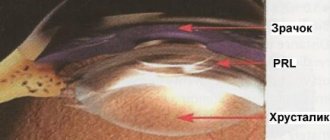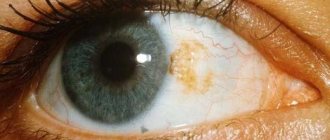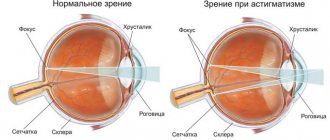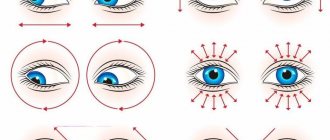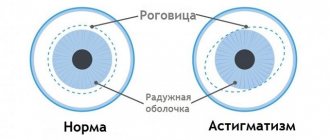Classification of persons with visual impairments
classification of persons with visual impairments
Classification of children according to the degree of visual impairment and visual capabilities
Depending on the preservation of visual acuity, several groups can be distinguished among children with visual impairments, characterized by different visual capabilities, different ways of perceiving educational material and orientation in space.
Depending on the degree of visual impairment and methods of perception of educational material, the following groups are distinguished:
a) blind and practically blind (so-called partially seeing) children with visual acuity ranging from O to 0.04, corrected by glasses in the better eye.
These children have little or no residual vision. During classes, they mainly use the tactile-auditory method of perceiving educational material, reading and writing in the Braille system. These children learn primarily through touch and hearing.
Some of them rely on residual vision when reading and writing. Along with this, if their vision allows them, they master, under certain conditions, the visual method of reading and writing enlarged black and white font. However, residual vision is not sufficiently stable and reliable. It can ensure the correctness and necessary speed of perception of ordinary flat-printed font only when using the sense of touch. Those who are partially sighted are subject to education in special schools for blind children or in special classes for these children at schools for the visually impaired.
During classes, the blind and partially sighted use special teaching aids (published in the Braille system), special technical means, and the necessary didactic material. Partially sighted people also use optics. All this allows you to master the techniques of tactile and visual reading and writing, facilitating the rational use and protection of residual vision;
b) visually impaired children with visual acuity ranging from 0.05 to 0.09, corrected by glasses in the better eye. These children typically have complex visual impairments.
classification of persons with visual impairments
Search
Lectures and workshop on psychology – Special psychology
Typhlopsychology is a section of special psychology that studies the psychological characteristics of persons with visual impairments as a result of a defect in the visual analyzer.
Diagnosis of visual acuity is traditionally carried out using special tables with different sizes of characters in 10 lines at a distance of 5 meters. The smallest characters visible on the bottom line determine visual acuity (visus) equal to 1.0. Further up the table, visual acuity decreases by 0.1, reaching 0.1 on the top line. The inability to distinguish the signs on the top line of the table transfers the diagnosis to the method of recalculating the fingers spread like a fan on the ophthalmologist’s hand (visual acuity with 5 m is 0.09; with 2 m - 0.04; with 0.5 m - 0.01; with 0. 3 m-0.005).
According to visual acuity impairment there are:
— blind (visus less than 0.005);
- partially blind (visus 0.005 - 0.04) with a narrowed field of vision (first form), with a peripheral scotoma (second form), with a central scotoma (third form);
— visually impaired (Vis 0.05 - 0.2).
Amblyopia (poor vision without visible damage to the eyes), depending on the shift in focal length, is defined as nearsightedness, or myopia (focus in front of the retina), and farsightedness (focus behind the retina), or hyperopia.
Blindness is differentiated as absolute (inability to distinguish light from dark, visu 0); household (inability to navigate in the immediate space of life activities to meet needs outside the familiar environment of the home without outside help); professional (insufficient vision for a particular professional activity). Amaurosis is blindness without visible damage to the eyes.
Based on the time of onset of blindness, a distinction is made between those born blind (including those born early - before 3 years of age, when visual images are not yet stored in memory) and those born blind (loss of vision after 3 years).
The causes of visual impairment in the vast majority of cases are congenital (genetic, pre- and perinatal), in minor cases - acquired: traumatic, nutritional-metabolic (lack of and metabolic disorders in the body), infectious nature.
Developmental anomalies include anapthalmos (absence of an eye), microphthalmos (smaller than normal eyes), colobomas of the retina and iris (lack of tissue, its ruptures), congenital cataracts (clouding of the lens as a result of embryonic vessels that have not resolved in it), color blindness (reduced sensitivity to red and green colors - more common among men).
Among the infectious diseases we note meningitis, measles, gonorrhea (blennorrhea of newborns), trachoma (chronic viral disease), helminthiasis (eye damage from worms), conjunctivitis (inflammation of the conjunctiva). Endocrine diseases can cause cataracts, and a lack of vitamin A can cause loss of visual acuity at dusk (the so-called “night blindness”). Damage to the optic nerve leads to the formation of a blind spot
Degrees and types of visual impairment
Not all blind people are completely blind; most have residual vision. In this case, a person with uncorrectable reduced vision is recognized as visually impaired. “Uncorrectable” means that vision is not improved by glasses or contact lenses. In this article we tell you what visual impairments are, what causes them and what types there are.
Degrees of vision loss
The World Health Organization offers a classification based on visual acuity in the best-corrected eye. When vision with glasses is in the healthy eye:
- from 20/30 to 20/60 - slight loss of vision or almost normal vision;
- from 20/70 to 20/160 - moderate vision impairment;
- 20/200 or worse—significant vision loss;
- 20/500 to 20/1000 - severe vision loss;
- less than 20/1000 - almost complete loss of vision;
- lack of light perception - complete loss of vision.
How does visual acuity affect a person?
Visual impairment varies greatly, so visual acuity does not guarantee the absence of problems with your ability to see. Some people with relatively sharp vision (eg 2040) may experience problems in daily life, while someone with reduced visual acuity (20200) may not experience any discomfort.
Vision loss is caused by various eye diseases, here are some of them:
- cataract - clouding of the lens of the eye;
- macular degeneration - damage to the retina, most often found in patients over 50 years of age;
- glaucoma is a disease of the optic nerve that develops due to increased eye pressure;
- diabetic retinopathy is a complication of diabetes. Because of it, branches begin to appear in the vessels supplying the retina.
- Retinal detachment is a serious disorder in which the retina becomes detached from the other layers of the eye.
How visual impairment manifests itself:
- Loss of central vision
. The outlines of objects become blurred or a blind spot forms. At the same time, peripheral vision is preserved. The person may have difficulty reading, recognizing faces, and seeing details in the distance. - Loss of peripheral (side) vision - “tunnel vision”
. Because of it, you can only see what is at eye level. Everything that is located below, above or on the sides of the eyes is not visible. This preserves central vision, allowing you to read or recognize faces. - Reduced contrast sensitivity.
This disorder reduces the quality of vision, making everything around you seem to be in a fog. Decreased sensitivity to contrasts can become a problem in everyday life: for example, a person may find it difficult to read if the color of the text is too pale. - Sensitivity to bright light.
Occurs due to overload of the visual system, the picture becomes dazzlingly bright. People with high sensitivity to light may experience pain and discomfort even in relatively normal light levels. - Night blindness
.
It prevents a person from seeing in the dark or in poorly lit places, such as a movie theater. Often occurs with diseases such as glaucoma, cataracts, and diabetes. In some cases, it may be a signal of A deficiency in the body. Source
Classification of visual impairments:
Blind (blind)
– a subcategory of persons with visual impairments who have a complete absence of visual sensations, have light perception or residual vision, as well as persons with progressive diseases and a narrowing of the visual field with visual acuity up to 0.08.
Visually impaired
– a subcategory of people with visual impairments who have visual acuity from 0.05 to 0.2 in the better seeing eye, corrected with ordinary glasses. In addition to decreased visual acuity, visually impaired people may have deviations in other visual functions (color and light perception, peripheral and binocular vision).
Features of development
With congenital or early blindness, the child does not receive any reserve of visual ideas; for some of them, the development of space and objective activity is delayed. Their ideas and knowledge about objects in the real world are meager and sketchy. Speech is often formed with a delay. At the same time, formed speech is often richer in vocabulary than that of sighted people. These children are noted to have a tendency to reason, but words often do not express their specific meaning or are used inappropriately. Blind children often learn abstract concepts more easily than concrete ones. They are characterized by a high level of development of verbal (verbal) memory. Perception and touch are developed.
Blindness inhibits a child's motor activity. Inactivity, lethargy, slowness and motor stereotypies arising against this background are characteristic features of the psychomotor skills of these children.
The formation of self-care skills is slow, and they are often not fully formed even by the time of schooling.
Features that arise in connection with partial loss of vision include some changes in the dynamics of needs (for example, a narrowing of the range of interests). In addition, the defect contributes, especially in the field of family education, to the emergence of conditions that adversely affect the formation of various character traits. Such conditions include both excessive care from others and lack of attention and abandonment of the child.
As a result, visually impaired preschoolers develop negative moral (self-centeredness, selfishness, lack of a sense of duty and camaraderie), volitional (lack of independence, indecisiveness, suggestibility, stubbornness, negativism), emotional (indifference to others, spiritual callousness) and intellectual (lack of curiosity, feelings new) character traits. The relatively limited contacts of the visually impaired with others entail isolation, lack of communication, and a desire to retreat into their inner world.
Psychology of children with dysfunctions of the musculoskeletal system (the essence of the disorder in cerebral palsy (CP), the causes of its occurrence; the structure of the motor defect in cerebral palsy; forms of cerebral palsy; features of the development of cognitive and emotional-volitional spheres in children with cerebral palsy, features of their activities).
cerebral palsy
is a group of movement disorders that occur when the motor systems of the brain are damaged and are manifested in the lack or absence of control by the central nervous system over the functioning of the muscles. In cerebral palsy, the interaction between the motor and sensory systems, and between the systems regulating voluntary and involuntary movements, is severely disrupted. Cerebral palsy is characterized by a violation of higher cortical function, signs of damage to the pyramidal tracts and subcortical nuclei.
Classification of persons with visual impairments.
Blind (blind)
- a subcategory of persons with visual impairments who have a complete absence of visual sensations, have light perception or residual vision (up to 0.04 on the better seeing eye with correction with glasses), as well as persons with progressive diseases and a narrowing of the visual field (up to 10 - 15 ) with visual acuity up to 0.08.
According to the degree of visual impairment, a distinction is made between persons with absolute (total) blindness in both eyes, in which visual perception is completely lost, and practically blind persons who have light perception or residual vision, which allows them to perceive light, color, and contours (silhouettes) of objects. Low vision
is a subcategory of people with visual impairments who have visual acuity from 0.05 to 0.2 in the better seeing eye, corrected with regular glasses. In addition to decreased visual acuity, visually impaired people may have deviations in other visual functions (color and light perception, peripheral and binocular vision).
Visual impairments can be congenital or acquired. Congenital blindness
caused by damage or diseases of the fetus during intrauterine development or is a consequence of the hereditary transmission of certain visual defects.
Acquired blindness
is usually the result of diseases of the visual organs - the retina, cornea and diseases of the central nervous system (meningitis, brain tumor, meningoencephalitis), complications after general diseases of the body (measles, influenza, scarlet fever), traumatic injuries to the brain (head wounds, bruises) or eyes .
There are progressive
and
non-progressive
disorders of the visual analyzer. With progressive visual defects, a gradual deterioration of visual functions occurs under the influence of the pathological process. For example, with glaucoma, intraocular pressure increases and changes occur in the tissues of the eye. Vision decreases with the appearance of brain tumors. If sanitary and hygienic conditions for writing and reading are not observed, myopia and farsightedness progresses. Non-progressive defects of the visual analyzer include some congenital defects, such as astigmatism and cataracts. The causes of these defects can also be the consequences of certain diseases and eye surgeries. So, dysfunctions of the visual analyzer can occur in children both during intrauterine development and after birth. Therefore, there are such categories of children with visual impairments as those born blind, those who became blind early, and those who lost their sight after three years of life. This differentiation is based on the fact that the time of vision loss is very important for the subsequent development of the child. For example, people born blind do not have visual images in their memory, which blind people have in varying degrees and volume. The time of onset of a visual defect is essential for the mental and physical development of the child. The earlier blindness occurred, the more noticeable are the secondary deviations, psychophysical characteristics and uniqueness of psychophysical development. The mental development of people born blind has the same patterns as that of sighted children, but the lack of visual orientation affects most noticeably the motor sphere and the content of social experience. A kind of landmark for a blind person is the reaction to sound, just as for a normally sighted person at an early age the reaction to sound stimuli, but for a blind person sound becomes the main factor of orientation. Loss of vision forms the uniqueness of the emotional-volitional sphere, character, and sensory experience. The blind have difficulties in playing, learning, and mastering professional activities. At an older age, people with impaired vision experience everyday problems, which causes complex experiences and negative reactions. In some cases, the uniqueness of the character and behavior of the blind affects the development of negative character traits in them: uncertainty, passivity, a tendency to self-isolation; in other cases - increased excitability, irritability, turning into aggressiveness. The development of higher cognitive processes (attention, logical thinking, memory, speech) in people born blind proceeds normally. At the same time, a violation of the interaction of sensory and intellectual functions is manifested in a certain originality of mental activity with a predominance of the development of abstract thinking. The difference between blind children and those born blind depends on the time of vision loss: the later the child lost his vision, the greater the volume of visual ideas he has, which can be recreated through verbal descriptions. If you do not develop visual memory, partially preserved after loss of vision, a gradual erasure of visual images occurs. A blind child has every opportunity for a high level of psychophysical development and full knowledge of the world around him, relying on a intact analytical network. In the conditions of special training, adequate techniques and methods of using auditory, skin, olfactory, vibration and other analyzers are formed, representing the sensory basis for the development of mental processes. Thanks to this, higher forms of cognitive activity develop, which are leading in the compensatory restructuring of perception. The system of compensatory restructuring at the initial stage of learning creates conditions for the correct reflection of the surrounding world in a visually effective form, and as social and everyday experience accumulates, in a verbal and logical form with the help of intact analyzer systems in the body of a blind child. Compensatory restructuring largely depends on the preservation of vision. Even minor remnants of vision are important for orientation and cognitive activity of persons with profound visual impairments.
Causes and signs of visual impairment
Vision plays a big role in the development of a preschool child, allowing one to perceive about 30% of information about the world around them. When forming visually effective thinking without visual perception, the pedagogical process becomes significantly more complicated. Visual impairment in preschool children can lead to changes in motivation for educational activities, a decrease in their creative activity, a slowdown in physical and mental development, and cause deviations in social behavior.
In the process of perceiving the surrounding world with the help of vision, we learn about the shape, size, color of objects, their spatial arrangement and the degree of their remoteness. We obtain such rich information through various vision functions. The main functions of vision include: visual acuity, color discrimination, visual field, type of vision and oculomotor functions. A decrease in any of them inevitably entails disturbances, both during the process itself and as a result of visual perception. Thus, impaired visual acuity reduces the resolution of the eye, accuracy, completeness and speed of perception, which makes it difficult and slower to recognize objects and images.
Vision allows us not only to see everything that surrounds us. Thanks to him, we can admire all the delights of the world, from various natural phenomena to the various delights of civilization. Today there is a very unfortunate trend in which the population of our country is rapidly deteriorating in vision.
At the same time, vision deterioration occurs even in children, and in most cases it is our fault.
Nowadays, technology in the modern world is moving forward. Smartphones, computer games, tablets, laptops.
Family dinners and common interests are a thing of the past - but with this we have lost a lot... Someone will say: “This is all modern technology, gadgets.” This is another reason for visual impairment in children.
Visual impairments can be congenital or acquired. Not only computer games, but also acute infections (influenza, measles, diphtheria) lead to the emergence of acquired forms of visual disorders.
A sharp decrease in vision can often be caused by diseases of the central nervous system: meningitis, encephalitis, brain tumors, and skull injuries. Among the causes of acquired forms of visual disorders, eye injuries play a certain role, which provoke clouding of the cornea, the development of traumatic cataracts, and in some cases, the death of the entire apple [1, p. 8].
The causes of congenital visual pathology are also diverse. Hereditary factors are the cause of congenital cataracts, hydrophthalmos, myopia, microphthalmos. Congenital eye changes in children can be a consequence of viral and infectious diseases suffered by the mother during pregnancy.
Thus, eye diseases can occur under the influence of various causes.
Signs of possible visual impairment, in which the child should be shown to an ophthalmologist:
– the child often has reddened eyes, he avoids looking at the light;
– eyes often water, there is discharge;
– the child often squints and closes his eyelids tightly;
– while watching something, the child often tilts his head to the side and examines objects or pictures from a very close distance;
– the child often has a headache;
– strabismus, even if it is barely noticeable or appears from time to time;
– clouding or clouding of the pupils (the lens becomes thick and light has difficulty passing through it);
– dryness of the mucous membrane of the eye;
– blurred image (impaired accommodation).
To avoid visual impairment in children, first of all, young parents should lead a healthy lifestyle, especially mothers during pregnancy and lactation. When raising children, parents should always set a good example of their attitude to their health and, in particular, to preserving their vision. It is necessary to take care of vision both from birth and in early preschool age, when it is still possible to promote the correct development of eye refraction and normal visual acuity. For the effectiveness of work on the prevention and correction of vision, it is necessary to create special conditions that facilitate the timely identification of problems associated with diseases of the visual organs and the highest quality treatment.
When the first signs of visual impairment appear, it is necessary to contact children's medical institutions and undergo a comprehensive examination of the visual organs. Conditions must be created at preschool educational institutions to preserve the health of children. And in most cases, they are created and aimed at protecting children’s vision. It should also be noted that the effectiveness of preventive measures in preschool educational institutions depends on the availability of qualified personnel and specialized equipment that allows examination and carrying out treatment, preventive and correctional work.
Literature:
- Nagaeva T.I. Visual impairment in preschool children: development of spatial orientation, Ed. Rostov n/d: Phoenix, 2010. - 92 p.
- Plaksina L. I. Development of visual perception in children with visual impairments. — M., 2015
- https://domadoktor.ru/179-narushenie-zreniya.html
- https://budzdorov-kaluga.ru


